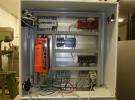Hello,
I am struggling to get proper measurements on the analog inputs of my T7. I guess it's some simple thing that I'm missing, but I coudn't find an answer in the app notes, specs or forum so I'm starting this new topic. It's possible that the answer was somewhere there and I didn't understood it - if so I'd be grateful for pointing it out and explanation.
I am planning to use my T7 to acquire data from several different devices in which quite few of them will be various types of optical detectors and pressure transducers. Before putting my system together I tried several different scenarios:
- I connected 5V DC power supply to AINx and GND - when switched off reading is 0 when switched on reading is 5V. ok
- I tried to read the data from pressure transducer and connected the singal cable to the AINx and linked the GND on T7 with the ground from power supply to this transducer it also worked fine - the channel was set for -10 to +10 range and negative channel to GND and all the voltages that were read were in range 0 to 5 as per specs of that specific sensor. great!
- I tried to measure the voltage from a battery powered optical detector (biased Si photodiode - for this test I used DET10A/M from Thorlabs ). This detector gives signal from 0 to 10 V so my AINx was again set for -10 to +10 range and negative channel to GND. The detector has a BNC output and I connected the negative to GND and positive to AIN.. but the readings were very strange. When the detector is connectd, swithced OFF and optically blocked it gives reading about -5V (btw - all the readings are taken from Kipling right now). when I uncover the detector it gives reading of approx +5V, but it does not react as it is expected when I decrease amount of light into the detector. Additionally - all these reading changes come with the detector switched OFF (well the switch is probably only for the bias and amplifier) and switching in ON is not changing the readings at all. The detector reads as expected with scope and multimeters in range 0 to 10 so there is somethig I'm doing wrong here. I tried to connect the groind from bnc as differencial to AINx+1 and use it like that but it does not work - it is unipolar device.
- I tried to measure signal from a signal generator - producing low frequency (10Hz) triangle signal from 0 to 4V. Again - this signal was sent via BNC and this was connected as positive to AIN and negative to GND. Again very strange readings on negative values. I am totally confused and do not know what to do to properly read voltages on my T7
I know that this was probably discussed many times before but if somebody could help here I would be very grateful as I runned out of ideas.
Best regards
Adam



.png%3Fitok=PHGBxf6M)


.jpg%3Fitok=B1YcuDFK)
.png%3Fitok=Ybt-OlgU)
A 10 Hz triangle wave would be tough to read in Kipling. Kipling reads analog inputs once per second I believe, so who knows where you will be at on the triangle. Instead use LJStreamM to view the waveform.
AINx to GND is likely the correct connection. Connect the DMM, scope and T7 all at the same time so you can compare readings from all at the same time.
One thing with light sensors is realize that lights powered by AC typically produce a light waveform, not steady light. With the scope do you see a steady DC voltage or a waveform?
Hi,
Thanks for your feedback. Some more tests gave me more light on the issue and I think I will have the solution now. When testing with the signal generator it didn't work as expected when the load was set to 50Ohm, but when I set the output load to 1kOhm then the T7 was reading proper values.
Regarding the photodiode - The T7 reads some strange values when only detector connected to AINx and GND but DMM reads everything properly. It is a DC measurement (but also powered by a DC battery). Yet when I will connect the DMM and T7 at the same time the readings on both devices are correct.
Both these tests suggest that the probelm is a load mismatch between the device and T7 and when DMM is connected to photodiode it loads the connection appropriately.
What is the spec'ed termination for the T7 ports? Is 1kOhm the correct termiantion to use?
Thanks
Adam
The T7 analog inputs have low bias currents and very high input impedance:
https://labjack.com/support/datasheets/t-series/appendix-a-3-2-1-t7-general-specs
Most signals connect direct to the analog inputs and use no termination or load.
When you say "set the output load to 1kOhm", is this a setting on your signal generator?
Your DMM likely has 1M or 10M across the inputs, so conneting the DMM is like adding 1M or 10M from AINx to GND. It could be the analog input bias currents happen to be negative (e.g. -10 nA) at the voltage you are at, and some weakly driven signals struggle with negative bias currents, so the small load (1M or 10M) might draw just enough current that the net from the photodiode is positive. Try just adding a 1M or 10M from AINx to GND to see if that does it.
A quick look at the manual for the DET10A/M seems to suggest it provides a raw current output and the proper load resistance is required to get a voltage signal. It mentions 50 ohms. Or maybe you have a signal conditioner that is supposed to be providing a voltage output?
Thank you very much for your reply and comments! It looks like it has been the problem with proper termination and loading of that specific detector.
Regarding signal generator - yes, it has built in function to set load on the output so changing this from 50Ohm to 1kOhm helped with the signal generator.
Thank you again for your help!